The IRS W-9 form is primarily used to provide your taxpayer identification information to individuals or businesses that are required to report payments made to you. This could include payments for services rendered, interest, dividends, or other income. By completing this form, you help ensure that the correct information is reported to the IRS.
Individuals and businesses who receive income that must be reported to the IRS typically need to fill out a W-9 form. This includes:
-
Freelancers and independent contractors
-
Corporations and partnerships
-
Real estate transactions
-
Financial institutions for interest and dividends
If you are unsure whether you need to complete a W-9, consult with a tax professional.
Completing a W-9 form is straightforward. Follow these steps:
-
Provide your name as it appears on your tax return.
-
Enter your business name if applicable.
-
Fill in your address, including city, state, and ZIP code.
-
Indicate your taxpayer identification number (TIN), which can be your Social Security Number (SSN) or Employer Identification Number (EIN).
-
Sign and date the form to certify that the information is correct.
Once completed, submit the form to the requester, not to the IRS.
If your name, address, or taxpayer identification number changes, you should fill out a new W-9 form and submit it to the requester. Keeping your information up to date is essential for accurate tax reporting.
No, the W-9 form is not submitted directly to the IRS. Instead, it is provided to the person or business that requests it. They will use the information on the W-9 to complete their own tax reporting forms, such as the 1099.
If you do not provide a W-9 form when requested, the payer may withhold a percentage of your payments for tax purposes. This is known as backup withholding. It's important to provide the form to avoid unnecessary withholding and ensure accurate reporting of your income.
